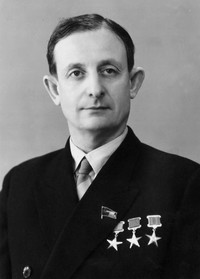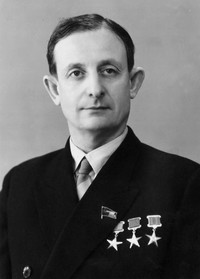Rosatom
Khariton Julius Borisovich (1904-1996)

Physicist, one of the leaders of the Soviet atomic project, academician of the USSR Academy of Sciences (1953). In 1939-1941, together with Ya. B. Zeldovich, he calculated the chain reaction of division in uranium. Since 1945 – Scientific adviser KB -11. In 1945-1953 – Member of the Technical Council of the Special Committee and the NTS PSU at the Council of Ministers of the USSR. Three times Hero of Socialist Labor (1949, 1951, 1954). Laureate of Leninsky (1956) and three state (1949, 1951, 1953) USSR Prizes.
Julius Borisovich Khariton was born on February 14 (February 27 in the new style) in 1904 in St. Petersburg in the family of journalist Boris Iosifovich Khariton and the artist of the Moscow Art Theater Mirra Yakovlevna Burovskaya. In addition to him, there were two daughters in the family: Lydia (born in 1899) and Anna (born in 1901).
In 1915, Julia was determined in a real school, the course of which he completes in 1919. Since he had been accepted in higher educational institutions from 16 years old, he had to work out a meeman student in a railway telegraph workshop for a year. In 1920, at the age of 16, Julius Borisovich entered the Leningrad Polytechnic Institute. Here he listened to the lectures of the Patriarch of Russian physics A.F. Ioffe, which excited a young student of interest in physics. A year after the start of study, Yu.B. Khariton switched from an electromechanical to the Physics and Mechanical Department, which he graduated in 1925, receiving a diploma of physics engineer.
While still a student, Julius Borisovich since 1921 at the invitation of N.N. Semenova began working in his laboratory created at the Physics and Technology Institute, the director of which was A.F. Ioffe. In this laboratory, Julius Borisovich completed his first research. His first works (1924) was to determine the critical temperature of the condensation of metal vapors and joint with N.N. Semenov and A.I. Shalnikov studies of the interaction of molecules from the surface of solid bodies. In 1925, the “Purcher in Physics” was published, written by A.F. Walter, V.I. Kondratiev and Yu.B. Khariton, when they were still students. The taskman was deservedly popular among several generation students. At the age of 20 Yu.B. Khariton together with Z.F. Valta performed and published the scientific work “Oxidation of phosphorus vapors at small pressure”, in which for the first time experimentally showed the existence of branched chain chemical reactions using the example of the oxidation of phosphorus. The discovery of this phenomenon in the future was a strong basis of N.N. Semenov theory of branching chain reactions, for which he was awarded the Nobel Prize in 1956. On its monograph “Chain Reactions”, released in 1934, N.N.Semenov made a dedicatory inscription: To dear Yuli Borisovich, who was the first to push my thought into the field of chain reactions.
In 1926, Khariton was sent on a two-year scientific trip to England to the famous Cavendish Laboratory. Here, under the guidance of Rutherford and Chadwick, he completed work on the method of detecting alpha particles, and in 1928 he defended his thesis for a Ph.D. Returning to Russia, Khariton conducted pedagogical work at the Polytechnic Institute for 10 years, and also resumed work at N.N. Semenov in the physicochemical sector of the Physico-Technical Institute. He consciously and purposefully chooses a new direction for his future activities. In 1931, the physicochemical sector was transformed into the Institute of Chemical Physics, where Khariton organized and headed the Laboratory of Explosives (BB), which soon became the generally recognized school of explosion physics.
Before the war, Khariton took up research on the chain fission of uranium. In 1939, an article by Yu.B. Khariton and Ya.B. Zel'dovich On the issue of the chain decay of the main isotope of uranium, and the article On the chain decay of uranium under the interaction of slow neutrons was prepared. The main conclusion from these works is the need to enrich uranium with a light isotope in order to implement a nuclear chain reaction. When conducting research on the fission of uranium nuclei, Yuliy Borisovich actively communicated with I.V. Kurchatov and in 1940 joined the uranium commission of the USSR Academy of Sciences.
During the Great Patriotic War, Khariton, using the experience and knowledge of explosion physics, carried out extensive experimental and theoretical work to substantiate new types of weapons of the Red Army and study new types of enemy weapons, as well as surrogate explosives, while continuing to lead the department of the theory of explosives at the Institute of Chemical Physics .
In 1943 I.V. Kurchatov, who headed the Atomic Project in the USSR, involves Khariton in the development of atomic weapons and enrolls him in Laboratory No. 2 of the USSR Academy of Sciences. The choice of I.V. Kurchatov is conscious and unequivocal – to involve the leader of domestic science in chain reactions in the implementation of a chain reaction of a nuclear explosion.
In May 1945, the USSR, together with its allies (USA, Britain and France), completed the defeat of Germany and celebrated the Victory. Yu.B. Khariton was included in a group of physicists to ascertain the state of German research on nuclear weapons, which flew to Berlin in May. One of the significant results was discovered by Yu.B. Khariton and I.K. Kikoin about a hundred tons of uranium oxide.The head of the group A.P. Zhenyagin organized the sending of uranium oxide to Moscow. I.V. Kurchatov said that the Uranus found in Germany for about a year reduced the launch of an industrial reactor in the Urals to develop plutonium.
On August 20, after the atomic bombing of Hiroshima and Nagasaki, the State Defense Committee adopted a resolution on the creation of a special committee (chairman – L.P. Beria), endowed with extraordinary powers, which was to lead the leadership to solve the problem. To consider scientific and technical issues on the atomic problem, the Technical Council was created at the Special Committee. I.V. Kurchatov and Yu.B. Hariton.
In 1946, a resolution of the Council of Ministers of the USSR for the direct creation of an atomic bomb organized a branch of laboratory No. 2-Design Bureau (KB-11). The country's leadership appoints the chief designer of the atomic bomb, and then the scientific director of nuclear charges and nuclear ammunition Yu.B. Hariton
From this moment on, life and work of Yu.B. Khariton is inextricably linked with overcoming the nuclear monopoly of the United States, the creation of our atomic bomb, and then the development and improvement of domestic nuclear weapons. It was a grandiose work on its scale, on the development of many scientific and technical fields of knowledge, of which a nuclear-malignant technology consists of, and in its military-political significance.
That's how Yu.B. Khariton describes our country's entry into the atomic era: “I am amazed and worshiped before what was done by our people in 1946-1949. It was not easy and later. But this period in tension, heroism, creative take -off and dedication cannot be described. Only a strong spirit, after such incredibly difficult trials, could make it completely out of the ordinary: a half -starved and just emerged from a devastating war, the country has developed and introduced the latest technologies in a few years, established the production of uranium, over -clean graphite, plutonium, and heavy water.
As the scientific director of VNIIEF Yu.B. Khariton remained for 46 years, until 1992, when he became an honorary scientific director of VNIIEF. The exceptional talent of the scientist and organizer of science allowed Khariton to successfully lead the main areas of scientific and design work of the institute. In terms of working capacity and endurance, he had no equal, as in creative longevity. For almost half a century, he was the chairman of the scientific and technical council of the Minatoma for Nuclear Weapons.
Using great influence and possessing an amazing gift to details to understand any scientific and technical matters, with abundance of sentences and points of view of individual scientists and institutions, he was able to choose the most valuable ideas and implement them into new outstanding constructions. When disagreements arose between the institutes, Yu.B. Khariton always sought to understand in detail their causes and the essence of new sentences and ideas. Thanks to his skillful leadership and the highest personal authority, it was possible to find optimal solutions.
A lot of brilliant scientists and leaders took part in the domestic atomic project. But among these prominent people, Julius Borisovich was a phenomenon. Its uniqueness was that he was not only a theoretic physicist, but also an outstanding experimenter, designer-technologist, creator of the production system, operation and testing of nuclear weapons.
He took upon himself and was full of responsibility not only for everything regarding the development of nuclear weapons and its continuous progress, but also for the safety of production, testing and operation of this no analogues in the destructive strength of weapons.
Yu.B. Khariton was the first to formulate the requirements for the safety of nuclear weapons, talked about the inadmissibility of a nuclear explosion in all random situations in which nuclear weapons could be. Thanks to his exactingness, we still had no breakdown, failures and avoided nuclear weapons.
He was the creator of the history of not only the nuclear weapons of our country, but also many human destinies, devoting his life to science, which saved the world from terrible war in its consequences. Its exceptional activities and creative achievements amaze and cause amazement. Yu.B. Khariton is the creator of a number of scientific schools in a wide variety of areas of physics and technology. Among his students are outstanding scientists.
All the leaders of our state from Stalin to Yeltsin listened to the quiet voice of this man. And in the fact that with Minata/Rosatom – the only giants of the domestic military -industrial complex survived and continues to exist, in many ways his merit.
The country praised the activities of Yu.B. Hariton. He is three times Hero of Socialist Labor, laureate of Lenin and state prizes, awarded six Orders of Lenin, Orders of the Red Star, the October Revolution, the Red Banner of Labor, the Academy of Sciences of the USSR, the Academy of Sciences of the USSR since 1953, was awarded the highest awards of the Russian Academy of Sciences. Golden medals them. M.V. Lomonosova and I.V. Kurchatov.
At the end of his life path, Julius Borisovich Khariton with particular acuteness felt his as a scientist and man, responsibility for the future of mankind. His testament began to all the words: Stronging for the better, not to do the worst.
